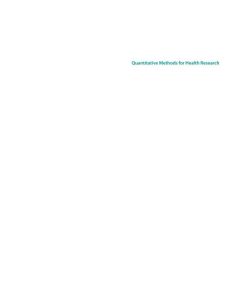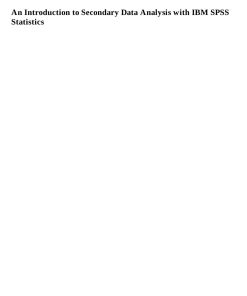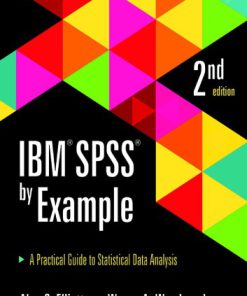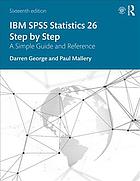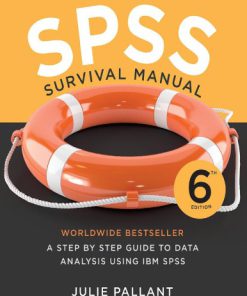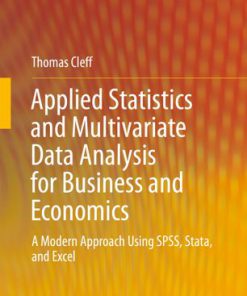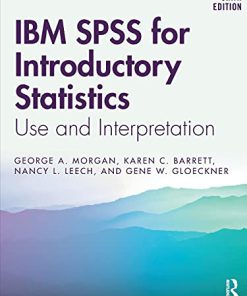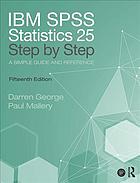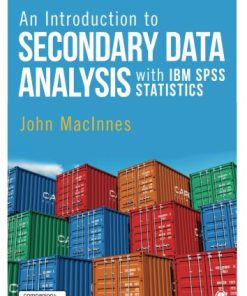Quantitative Analysis and IBM SPSS Statistics A Guide for Business and Finance 1st Edition by Abdulkader Aljandali 3319455280 9783319455280
$50.00 Original price was: $50.00.$25.00Current price is: $25.00.
Quantitative Analysis and IBM SPSS Statistics A Guide for Business and Finance 1st Edition by Abdulkader Aljandali – Ebook PDF Instant Download/DeliveryISBN: 3319455280, 9783319455280
Full download Quantitative Analysis and IBM SPSS Statistics A Guide for Business and Finance 1st Edition after payment.
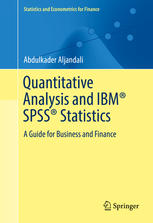
Product details:
ISBN-10 : 3319455280
ISBN-13 : 9783319455280
Author: Abdulkader Aljandali
This guide is for practicing statisticians and data scientists who use IBM SPSS for statistical analysis of big data in business and finance. This is the first of a two-part guide to SPSS for Windows, introducing data entry into SPSS, along with elementary statistical and graphical methods for summarizing and presenting data. Part I also covers the rudiments of hypothesis testing and business forecasting while Part II will present multivariate statistical methods, more advanced forecasting methods, and multivariate methods. IBM SPSS Statistics offers a powerful set of statistical and information analysis systems that run on a wide variety of personal computers. The software is built around routines that have been developed, tested, and widely used for more than 20 years. As such, IBM SPSS Statistics is extensively used in industry, commerce, banking, local and national governments, and education. Just a small subset of users of the package include the major clearing banks, the BBC, British Gas, British Airways, British Telecom, the Consumer Association, Eurotunnel, GSK, TfL, the NHS, Shell, Unilever, and W.H.S. Although the emphasis in this guide is on applications of IBM SPSS Statistics, there is a need for users to be aware of the statistical assumptions and rationales underpinning correct and meaningful application of the techniques available in the package; therefore, such assumptions are discussed, and methods of assessing their validity are described. Also presented is the logic underlying the computation of the more commonly used test statistics in the area of hypothesis testing. Mathematical background is kept to a minimum.
Quantitative Analysis and IBM SPSS Statistics A Guide for Business and Finance 1st Table of contents:
Part I: Introduction to IBM SPSS Statistics
Chapter 1: Getting Started
1.1 Creation of an IBM SPSS Statistics Data File
1.1.1 The IBM SPSS Statistics Data Editor
1.1.2 Entering the Data
1.1.3 Saving the Data File
1.2 Descriptive Statistics
1.2.1 Some Commonly Used Descriptive Statistics
1.2.2 Levels of Measurement
1.2.3 Descriptive Statistics in IBM SPSS Statistics
1.2.4 A Discussion of the Results
1.3 Creation of a Chart
1.4 Basic Editing of a Chart and Saving it in a File
Part II: Data Examination and Description
Chapter 2: Graphics and Introductory Statistical Analysis of Data
2.1 The Boxplot
2.2 The Histogram
2.3 The Spread-Level Plot
2.4 Bar Charts
2.5 Pie Charts
2.6 Pareto Charts
2.7 The Drop-Line Chart
2.8 Line Charts
2.9 Applying Panelling to Graphs
Chapter 3: Frequencies and Crosstabulations
3.1 Data Exploration via the EXPLORE Routine
3.2 Statistical Output from EXPLORE
3.3 Univariate Frequencies
3.4 Cross Tabulation of Two Variables
3.4.1 The Recode Procedure
3.4.2 The IBM SPSS Statistics Crosstabs Procedure
3.4.3 Calculation and Interpretation of the Chi Square Statistic
3.4.4 Other Statistics Available in the Crosstabs Procedure
3.5 Customizing Tables
Chapter 4: Coding, Missing Values, Conditional and Arithmetic Operations
4.1 Coding of Data
4.1.1 Defining Missing Values
4.1.2 Types of Missing Value
4.2 Arithmetic Operations
4.3 Conditional Transforms
4.4 The Auto Recode Facility
Part III: Hypothesis Tests
Chapter 5: Hypothesis Tests Concerning Means
5.1 A Review of Hypothesis Testing
5.2 The Paired t Test
5.2.1 Computation of the Test Statistic for the Paired t Test
5.2.2 The Paired t Test in IBM SPSS Statistics
5.3 The Two Sample t Test
5.3.1 Computation of the Test Statistic for the Two Sample t Test
5.3.2 The Two Sample t Test in IBM SPSS Statistics
5.4 The One-Way Analysis of Variance
5.4.1 Computation of the Test Statistic for the One-Way ANOVA
5.4.2 The One-Way ANOVA in IBM SPSS Statistics
5.4.3 Discussion of the Results of the One-Way ANOVA
Chapter 6: Nonparametric Hypothesis Tests
6.1 The Sign Test
6.1.1 Computation of the Test Statistic for the Sign Test
6.1.2 The Sign Test in IBM SPSS Statistics
6.2 The Mann–Whitney Test
6.2.1 Computation of the Mann–Whitney Test Statistic
6.2.2 The Mann–Whitney Test in IBM SPSS Statistics
6.3 The Kruskal–Wallis One-Way ANOVA
6.3.1 Computation of the Kruskal–Wallis Test Statistic
6.3.2 The Kruskal–Wallis Test in IBM SPSS Statistics
Part IV: Methods of Business Forecasting
Chapter 7: Bivariate Correlation and Regression
7.1 Bivariate Correlation
7.2 Linear Least Squares Regression for Bivariate Data
7.3 Assumptions Underlying Linear Least Squares Regression
7.4 Bivariate Correlation and Regression in IBM SPSS Statistics
Chapter 8: Elementary Time Series Methods
8.1 A Review of the Decomposition Method
8.2 The Additive Model of Seasonal Decomposition
8.3 The Multiplicative Model of Seasonal Decomposition
8.4 Further Points About the Decomposition Method
8.5 The One Parameter Exponential Smoothing Model
8.5.1 One Parameter Exponential Smoothing in IBM SPSS Statistics
8.5.2 Further Points About Exponential Smoothing
Part V: Other Useful Features of IBM SPSS Statistics
Chapter 9: Other Useful Features of IBM SPSS Statistics
9.1 The IBM SPSS Statistics Help System
9.2 Saving IBM SPSS Statistics Syntax
9.3 The IBM SPSS Statistics Coach
Chapter 10: Secondary Sources of Data for Business, Finance and Marketing Students
10.1 Business and Finance Data Sources
10.1.1 Eurostat
10.1.2 OECD
10.1.3 UK Office for National Statistics (ONS)
10.1.4 UK Data Service
10.1.5 The International Monetary Fund
10.1.6 The World Bank
10.1.7 International Business Resources on the Internet
10.1.8 Miscellaneous Sources
10.2 Marketing Data Sources
10.2.1 Marketing UK
10.2.2 Datamonitor
10.2.3 The Market Research Society (MRS)
People also search for Quantitative Analysis and IBM SPSS Statistics A Guide for Business and Finance 1st:
what is spss in quantitative data analysis
what is ibm spss statistics
ibm spss statistics use
ibm spss descriptive statistics
quantitative analysis and statistics
Tags: Quantitative Analysis, Statistics, Business, Finance, Abdulkader Aljandali
You may also like…
Mathematics
IBM SPSS Statistics 26 Step By Step A Simple Guide And Reference 16th Edition Darren George
Relationships & Lifestyle - Psychological Self-Help
Business & Economics - Professional Finance
Computers - Applications & Software




